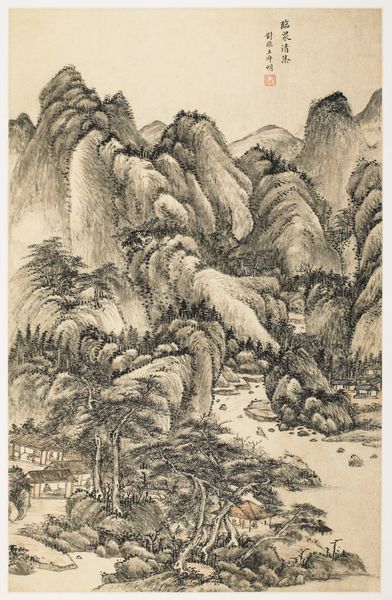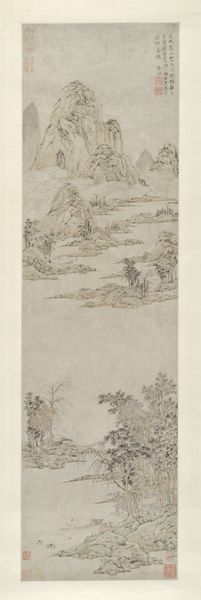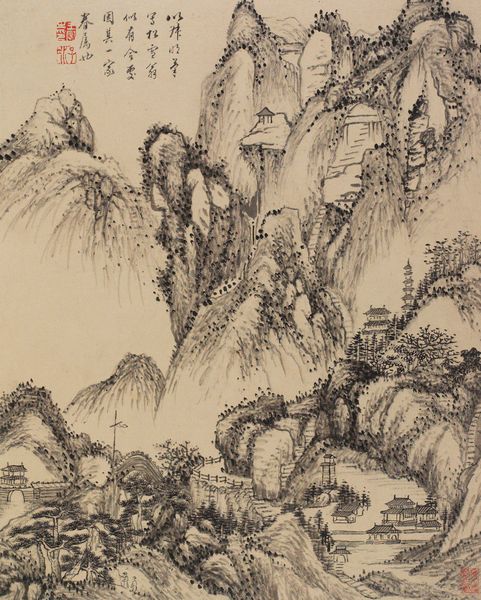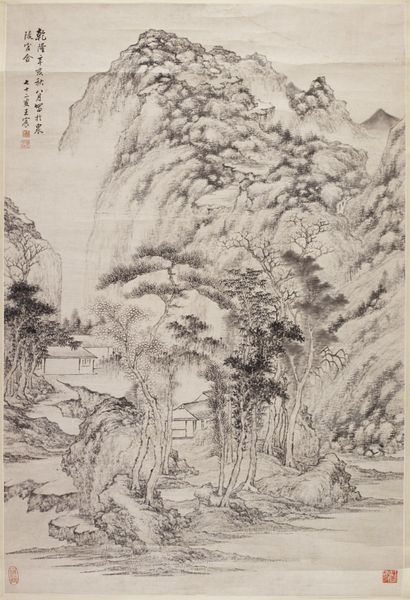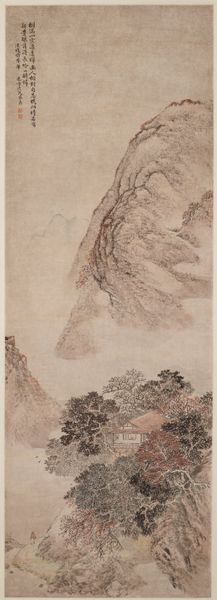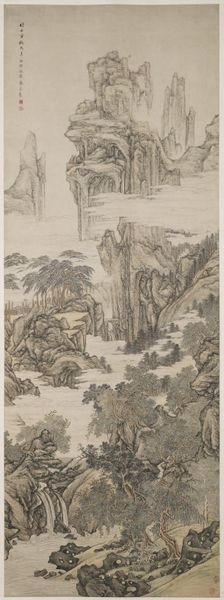
drawing, paper, ink-on-paper, hanging-scroll, ink
#
drawing
#
narrative-art
#
asian-art
#
landscape
#
paper
#
ink-on-paper
#
hanging-scroll
#
ink
#
geometric
#
orientalism
#
china
#
calligraphy
Dimensions: 39 x 18 7/16 in. (99.06 x 46.83 cm) (image)
Copyright: Public Domain
Editor: We're looking at Wang Chen’s "Landscape after Dong Yuan," created around 1775 using ink on paper. It's a hanging scroll, currently held at the Minneapolis Institute of Art. There's something so calming about it. All those carefully rendered details really pull me in, what catches your eye in this piece? Curator: Immediately, the composition asserts itself. The artist uses a vertical format to present a panoramic view, manipulating spatial recession through varied ink washes and line work. Consider how the mountain mass dominates the upper register, establishing a focal point that descends gradually into the lower plane. The interplay of geometric forms and organic shapes is carefully balanced. What does this contrast suggest to you? Editor: I guess, it brings a nice rhythm and flow to it; it is a well balanced mix. Does the calligraphy add a new dimension, changing how you interpret it? Curator: Indeed. Observe how the calligraphy integrates both visually and textually with the landscape. The placement mirrors the verticality of the mountains, reinforcing the overall structure. Also, notice how Wang employs a refined brushstroke technique that merges calligraphy and the image, underscoring its intentional formal harmony. This level of intentionality is central to the artwork's structural elegance. Editor: It is incredible that every stroke seems like an entire visual experience by itself, adding so much depth. Thanks! Curator: Precisely! That intentionality, as you observed, elevates the whole beyond the pictorial, turning ink into a semiotic device and each formal choice shapes meaning itself. Thank you for pointing out these fascinating elements; let's continue our exciting discussions, learning something new with each work.
Comments
minneapolisinstituteofart almost 2 years ago
⋮
Wang Chen was born in Tai Cang, Jiangsu province in 1720. He was a sixth generation descendant of the orthodox master Wang shimin (1592-1680) and the grandson of Wang Yuanchi (1642-1715). Wang passed the second-degree provincial exams in 1760 and later served as the prefect of Yongzhou in Hunan province. As a painter, Wang Chen carried on the well-established orthodox tradition of his family lineage which was derived from the Four Great Masters of the Yuan (1280-1368). Wang Chen was eventually classified along with Wang Yu, Wang Su, and Wang Jiu as the Four Lesser Wangs of the Qing dynasty. As with the present landscape, Wang's style is characterized by dry brush techniques. The painting is rendered almost entirely in spare, dry strokes of ink that seem to just graze the paper's surface. The result is a unified, elegant composition with remarkably few areas of wet ink. Typical of orthodox painters, homage is paid to past masters; in this case, according to the inscription, the great Five Dynasties landscape artist Dong Yuan (active 945-962). The reference, however, is vague as there is little of Dong Yuan's personal style in this landscape, but rather a synthesis of Song and Yuan styles reinterpreted by a middle Qing orthodox painter.
Join the conversation
Join millions of artists and users on Artera today and experience the ultimate creative platform.

